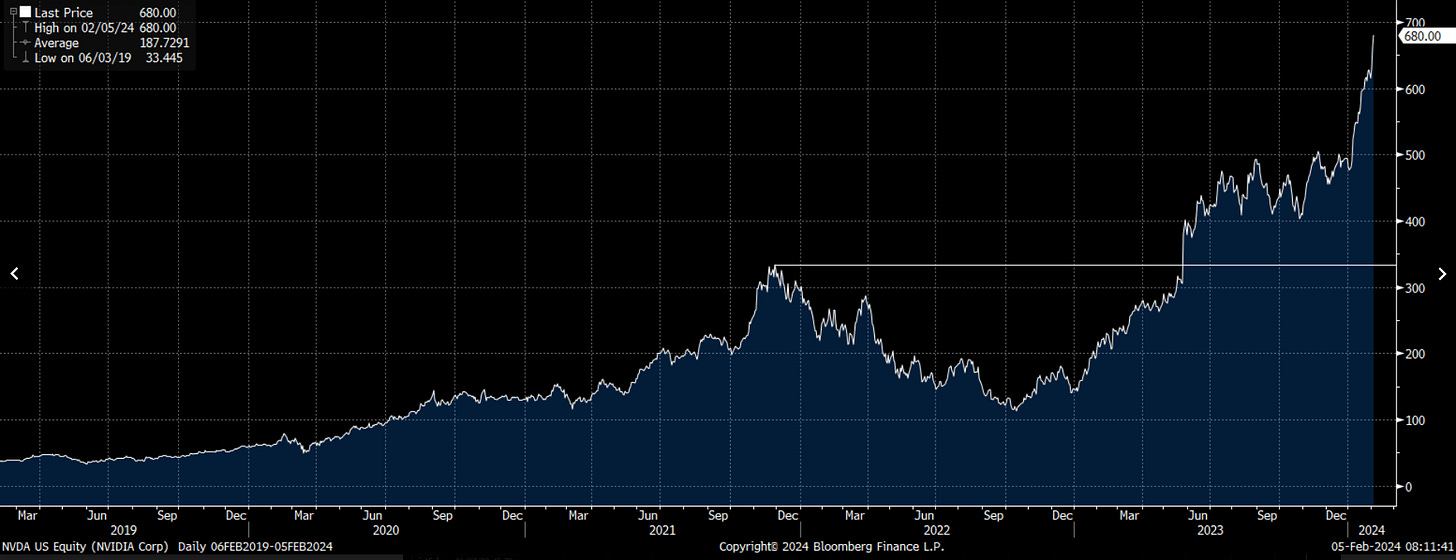Making Hay Monday - February 5th, 2024
High-level macro-market insights, actionable economic forecasts, and plenty of friendly candor to give you a fighting chance in the day's financial fray.
“Breakouts on weak…participation (market breadth) should be viewed with skepticism until proven otherwise.” -Craig Johnson, Chief Market Technician at Piper Sandler (as relayed by David Rosenberg in today’s Breakfast with Dave)
“A stock is not just a ticker symbol or an electronic blip; it is an ownership interest in an actual business, with an underlying value that does not depend on its share price.”
― Benjamin Graham
“With yields at 8% to 9%, and this type of value and attraction from other companies that are in the takeover type of business, I think that’s one clear example of what you should be buying relative to the Magnificent Seven.” -The former Bond King, Bill Gross, on the attraction of certain mid-stream energy companies and the takeovers that have been occurring in this sector
A Magnificent Double Nine
In the financial world, there has long been a tension, bordering on intense rivalry, between momentum and value investors. In the here and now, momentum players usually have the upper hand. This is likely an extension of Warren Buffett’s mentor Ben Graham’s famous quip that in the short run, the stock market is a voting machine; in the long run, it is a weighing machine. In other words, the market is a popularity contest in the near-term but, over time, intrinsic worth — aka, fundamentals — win out. (see also the Graham quote above) The subject of this Making Hay Monday is a situation that has both momentum and undervaluation on its side.
For the two most important broad indices, the S&P 500 and the NASDAQ, it’s a different story. On the positive side, the S&P has now clearly broken out to a new multi-year and all-time high (ATH). Previously, I had written that it was not yet decisive, but that’s no longer the case. Somewhat incongruously, considering tech’s utter performance domination last year and so far in 2024, the NASDAQ has not. Personally, I think it’s just a matter of time before it does.
What is undebatable is that several of its most important constituents have impressively shattered upside resistance. Meta (META) and Microsoft (MSFT) have both achieved that distinction. In each case, the breakouts have been driven by very strong earnings reports.
META - Five-Year Performance (Click chart to expand)
Microsoft Five-Year Performance - (Click chart to expand)
Accordingly, the odds are that the stock market will keep running, as will these two that have a combined market capitalization of over $4 trillion (about 70% of which is due to MSFT). This is not to say there isn’t a correction looming for both, and for the overall market. All three are quite extended presently. When that is the case, even critical breakouts are typically followed by declines, that, in some cases, can be notably violent.
Moreover, the stock market is selling at Tiffany prices, by most measures. This is despite the reality that outrageously high federal deficits have been inflating profits. Were the federal red ink to recede to more normal, but still bloated, levels, Corporate America’s earnings would be much lower. Thus, the S&P’s already stretched P/E would be even higher.
But momentum is a powerful force and another reason the stock market may well keep on running is that this is a seasonally strong period based on history. The months from October through April have, over the last century or so, been the most profitable; hence, the old Wall Street saw, “Sell in May and go away.”
META and MSFT (M&M) are, of course, members of that elite group once known as the Magnificent Seven. The reason for the “once” is because their numbers are dwindling. A case in point is Google. Lost in the euphoria over META’s and MSFT’s stellar earnings was a disappointing report by the company now known, for some bizarre reason, as Alphabet (GOOG). While revenue and profit growth were respectable, it wasn’t enough to satisfy Wall Street. Even as the M&Ms soared, GOOG took a 7.35% hit on Tuesday despite healthy sales and earnings growth. Seven-plus percent doesn’t sound like much, but that amounts to about a $153 billion market cap erosion, greater than the total value of most U.S. blue chips. Slightly disappointing advertising revenue was the rationale for the sell-off.
This illustrates the danger of lofty expectations. In fairness, GOOG is still up over 4% this year. It, too, appears to be breaking out and may well resume its uptrend. Its P/E on estimated 2024 profits is just 20, eminently reasonable relative to its robust fundamentals.
Other overachieving members of the Magnificent 7 are Amazon and Nvidia, particularly the latter. NVDA has continued to post spectacular sales and net-income growth. Its stock price gave another excellent buy signal when it exceeded its 2021 zenith last spring. That was when most of its Mag 7 peer group was still well below where it was trading back during what I have long-called Peak Insanity, the greatest equity bubble in U.S. history.
NVDA Five-Year Performance - (Click chart to expand)
Unlike with GOOG, valuations for AMZN and NVDA are elevated. And, as we saw last week with the former, even fairly valued stocks can take it on the chin. Consequently, I tend to gravitate toward companies whose shares are making new highs, clearly reflecting momentum, but also appear underpriced. That’s the subject of this week’s highlight. If you’ve been on the fence about becoming a paying subscriber, in my obviously biased view this week’s highlight is worth the price of admission on its own.







